When it comes to home décor, the walls of your living space are the perfect canvas for creativity. One of the easiest and most effective ways to enhance the appearance of any room is by using wallpaper wall coverings. These design elements are not only stylish but also provide practical benefits, making them a popular choice among homeowners and interior designers alike.

The Power of Wallpaper in Home Décor
Wallpaper has long been a popular option for adding texture, color, and pattern to walls. Unlike paint, wallpaper offers endless possibilities for customization. Whether you're looking for bold, vibrant patterns or a subtle, classic design, wallpaper can transform a room in an instant.
One of the biggest advantages of wallpaper is its versatility. It’s available in a wide range of styles, from floral patterns and geometric designs to faux textures like brick or wood. This makes it easy to match the wallpaper to your existing décor or create a bold statement piece in any room. Wallpaper can be used in living rooms, bedrooms, dining rooms, and even bathrooms, providing an instant upgrade to your interior design.
Wallpaper is also ideal for creating a focal point in a room. Whether it's a single accent wall or a whole room, wallpaper can draw attention to a particular area and set the tone for the entire space. For example, a bold, textured wallpaper can add depth and interest to a minimalist room, while a light, neutral pattern can create a calm and serene atmosphere in a bedroom.
Benefits of Using Wall Coverings
While wallpaper is a type of wall covering, the term "wall covering" is broader and encompasses a variety of materials designed to enhance the look and feel of your walls. Wall coverings can range from fabric and vinyl to wood panels and 3D wall tiles. These materials offer additional benefits that make them a great alternative to traditional wallpaper or paint.
Wall coverings such as vinyl or fabric offer practical advantages, including easy maintenance and durability. For instance, vinyl wall coverings are water-resistant, making them an excellent choice for areas like kitchens and bathrooms where moisture levels can be high. They are also easy to clean, which is an important consideration in homes with young children or pets. Fabric wall coverings, on the other hand, add warmth and texture to a room, creating a cozy and inviting atmosphere.
In addition to their aesthetic appeal, wall coverings can also provide soundproofing and insulation benefits. For example, some fabric wall coverings have acoustic properties that help reduce noise levels, making them perfect for home offices or media rooms. Other types of wall coverings, such as cork or foam panels, offer insulation properties that can help regulate temperature and improve energy efficiency in your home.
Choosing the Right Wallpaper and Wall Coverings
When selecting wallpaper or wall coverings, it’s important to consider the style and function of the room you are decorating. For example, in a living room or dining room, you may want to choose a statement wallpaper with bold colors and patterns to create a vibrant and energetic atmosphere. In a bedroom, on the other hand, you might opt for a softer, more tranquil design to promote relaxation and comfort.
Another key factor to consider is the material of the wallpaper or wall covering. If you're looking for something durable and easy to maintain, vinyl wallpaper or wall coverings are an excellent choice. If you’re aiming for a more luxurious and textured look, fabric or wallpaper with raised patterns might be more suitable.
The color of the wallpaper or wall covering also plays an important role in the overall mood of the room. Lighter colors can make a space feel larger and airier, while darker shades create a more intimate and cozy atmosphere. Patterns and textures also add visual interest and can help to mask imperfections on the walls, giving your space a polished and cohesive look.
How to Install Wallpaper and Wall Coverings
Installing wallpaper and wall coverings may seem like a daunting task, but it’s a straightforward process that can be tackled by DIY enthusiasts. If you're new to wallpapering, it's best to start with a small project, such as a single accent wall, to get the hang of the technique.
Before beginning installation, make sure to properly prep your walls. Clean them thoroughly to remove any dirt or grease, and patch up any holes or imperfections. For wallpaper, ensure the surface is smooth and dry before applying the adhesive. Some wallpapers come pre-pasted, while others require separate glue or paste. Always follow the manufacturer’s instructions for the best results.
For wall coverings such as vinyl or fabric, make sure to measure the area accurately to ensure the materials fit properly. You may also need to trim the edges to achieve a clean and seamless finish. If you’re not confident in your DIY skills, it may be a good idea to hire a professional to ensure the best outcome.
Conclusion
Wallpaper and wall coverings are powerful design tools that can elevate the look of any room in your home. Whether you choose wallpaper for its endless patterns and styles or opt for wall coverings for their practical benefits and durability, these elements can completely transform your space. With the right design choices and installation techniques, you can create a room that is both beautiful and functional.
So, if you're looking to refresh your home’s interior, consider using wallpaper and wall coverings as a way to add personality, warmth, and character to your living space. With so many options available, you're sure to find the perfect design to suit your style and enhance your home.